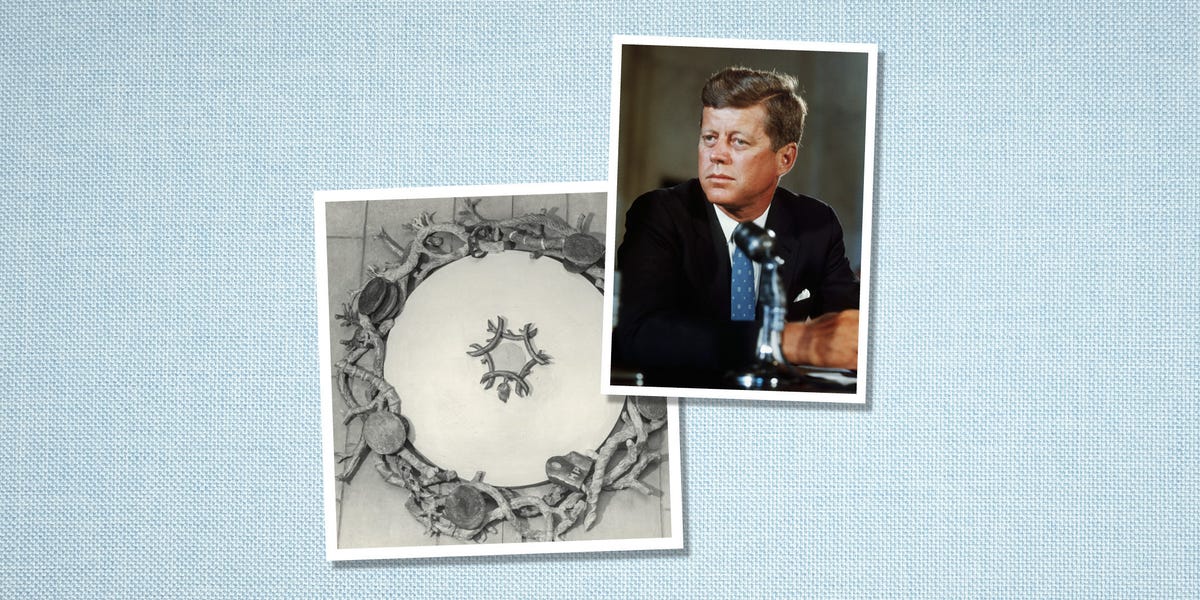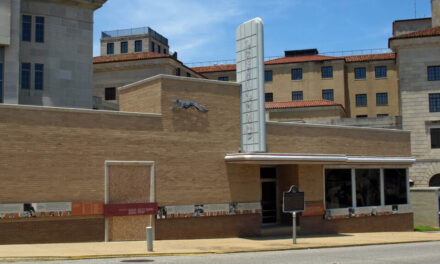
Earlier this year, employees at the John F. Kennedy Presidential Library and Museum pried open a series of unassuming boxes that had sat in storage for some five decades and uncovered a thrilling relic of presidential and aesthetic history: an intricately detailed, imposingly scaled metal wreath, designed by famed jeweler Jean Schlumberger, cast by sculptor Louis Féron, and meant to grace the official Kennedy gravesite at Arlington National Cemetery. The sculpture was divided into nearly a dozen pieces, each of which had been painstakingly packed into paper-filled cartons bearing assembly instructions on craft sticks attached to the piece with wire.
 Courtesy of Oak Spring Garden Foundation
Courtesy of Oak Spring Garden Foundation
Jeweler Jean Schlumberger (left), and sculptor Louis Féron (right)

Courtesy of Oak Spring Garden Foundation
The library staff—like most of the world—hadn’t even known that the wreath existed until a few months prior. Its discovery represented the end of a yearslong hunt that began in the same place where the wreath was first conceived: in Upperville, Virginia, at the one-time home of Mr. and Mrs. Paul Mellon. Its story is an astonishing saga of aesthetic and historical significance, whose characters include President Kennedy, Jacqueline Kennedy Onassis, Bobby Kennedy, Schlumberger, Féron, and politician and civil rights activist James L. Felder.
The friendship between the Mellons and the Kennedys is well documented: President Kennedy tapped Rachel “Bunny” Mellon to design his beloved Rose Garden at the White House, and Jackie considered Bunny one of her closest friends and most trusted confidants. Jackie consulted Bunny on everything from fashion to decorating to entertaining, so it follows that, in her darkest hour, she turned to Bunny to weigh in on her husband’s grave.
But how was a metal sculpture spanning over eight feet lost to history for nearly 50 years? And how was it found in early 2024? The answer to both of these questions begins at Oak Spring estate, now the site of the nonprofit Oak Spring Garden Foundation (OSGF), which carries on Bunny’s legacy through horticulture, environmental, and arts programs.
The Search Begins

Courtesy of Oak Spring Garden Foundation
“We came up here one day and there was some root formation in brass out there and Mr. Mellon said it was there to age, but then the next day, it was gone.” That’s how Oak Spring stoneworker Tommy Reed remembers the mysterious appearance—and disappearance—of a metal sculpture that he recalled seeing in the small private cemetery on the property’s expansive grounds, an anecdote he mentioned to Elinor Crane, wife of OSGF president Sir Peter Crane and de facto head of volunteer efforts at the foundation, one day in 2020.

Courtesy of Oak Spring Garden Foundation
Reed hadn’t thought too much about the odd temporary sculpture in the years between; after all, the Mellons were known to acquire and move quite a bit of art on a regular basis (following the death of his first wife, Mary Conover Brown, Paul used his Delano & Aldric–designed “Brick House” to store a dozen or so Degas dancers).
But when he mentioned it to Crane, who soon consulted OSGF assistant librarian and archivist Nancy Collins, he set off a thrilling search. What Reed most remembered about the sculpture, he said, was that it contained hats, a detail that led to numerous dead ends as Crane and Collins searched Oak Spring’s archives for any type of headwear.
Origins of the Wreath

Courtesy of Oak Spring Garden Foundation
Both the root formation in brass and those mysterious hats, it turns out, were an immortalization of a small but moving detail at President Kennedy’s funeral. The suddenness of his death meant that his initial grave, prepared for his funeral just three days after his assassination on November 22, 1963, was a hastily designed temporary one: a simple mound ringed in boughs and branches. After he was lowered into the ground, the honor guard attending the ceremony threw their hats on the wreath as a sign of respect to the late commander in chief.
This spontaneous tribute was so moving that Bobby Kennedy declared the hats should stay at his brother’s grave until they “crumble to dust.” They remained atop the boughs until the president was reinterred at his official gravesite about 20 feet east.

Courtesy of Oak Spring Garden Foundation
This evocative detail of the burial was confirmed for the OSGF team by Felder, the 10th-ever Black American to serve in the honor guard and author of the book I Buried John F. Kennedy. When Felder, who would go on to be a member of the South Carolina House of Representatives in addition to authoring three books, first reported to the honor guard in 1962, he was one of just seven Black soldiers in his 200-man unit; his presence was especially meaningful given President Kennedy’s passionate efforts to better integrate the U.S. military.
“For me, one of the most poignant outcomes of this whole project has been the opportunity to learn about the hats left at the gravesite by the honor guard on the day of the president’s burial in November 1963,” says Sir Peter Crane. “And even better, the opportunity to visit the Arlington National Cemetery with Sergeant Felder, who led the honor guard on that day as a true participant in history.”
The Memorial’s Design

Courtesy of Oak Spring Garden Foundation

Courtesy of Oak Spring Garden Foundation
When it came time to create that permanent memorial at Arlington, more than 150 proposals were considered before plans were finalized for President Kennedy’s permanent grave—it seemed no design could perfectly capture the legacy of a president who captivated the nation perhaps more than any before him (and, arguably, after). In the end, it was architect John Carl Warnecke who designed the site, with input from, of course, the president’s widow and family (especially his brother Bobby) as well as his secretary of defense, Robert McNamara (Arlington falls under the purview of this position)—and Bunny.
In 1964, Bunny received a letter from Warnecke that read, in part: “Mrs. Kennedy suggested, and I wholeheartedly agree, that the design has reached a point where we would like to consult with you.” Bunny’s input was significant: She specified the New England granite—a nod to her and the president’s shared connection with Cape Cod—around the simple central stone from which arises the eternal flame and selected the trees to encircle the gravesite, even going so far as to suggest where these might be sourced. She also spearheaded the commission of a metal wreath meant to commemorate the hats that had so moved Bobby Kennedy during his brother’s funeral.
Until recently, the reigning belief was that the sculpture was never created, that it existed solely in the form of ideas and sketches preserved in the extensive library at Oak Spring (including one sketch by Schlumberger that Bunny presented to Jackie at her house in Antigua in March of 1967). But Reed’s comment sparked a curiosity in the team there and they followed the scent. As they unraveled the decades-spanning mystery, Oak Spring commissioned writer Gretchen Ernster Henderson to record the process, which she outlines in a story for the Fall issue of the literary journal Ploughshares. But even while Henderson wrote her story, no one involved knew how it would end.
How the Wreath Was Found

Courtesy of Oak Spring Garden Foundation

Courtesy of Oak Spring Garden Foundation
The final piece in the wide-reaching puzzle came in the form of an April 1977 letter discovered in the Féron archives at the Museum of Fine Arts in Boston, requesting that the wreath be crated and shipped to the JFK Library in time for its June 1977 ground breaking. Oak Spring presented this to the staff at the library to suggest a search might be in order.
In February 2024, Oak Spring got word from the JFK Library: They had found the crates.
The wreath, as it turned out, had been hiding somewhat in plain sight: At the JFK Library, it wasn’t cataloged under wreath, grave, Schlumberger, Mellon, or any other terms that might more clearly indicate its significance. Instead it had been filed under Féron, the wreath’s fabricator and Schlumberger’s collaborator who, in a twist of irony, was often miffed at being overshadowed by Schlumberger.
Plans for the wreath’s future are still in the works: The first step is to continue the arduous process of carefully unpacking, inspecting, digitally scanning, and arranging the parts, before attempting to assemble the wreath based on its original instructions. Once this is done, pending the need for any restoration, the wreath will eventually be displayed, taking its rightful place as a rich, multifaceted symbol of American history.
Hadley Keller is the Director of Editorial and Community Engagement at the Design Leadership Network, a community of top interior designers. She has covered design, interiors, and culture for over 10 years.




